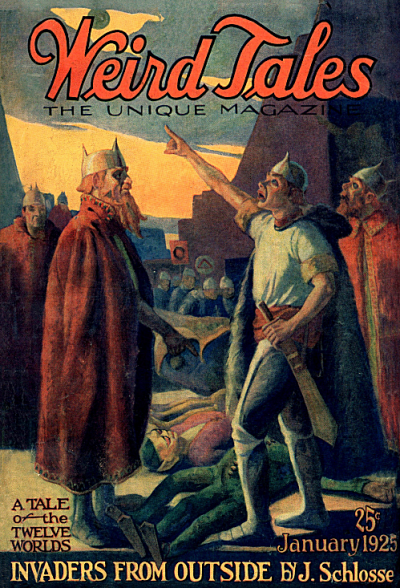INVADERS FROM OUTSIDE (8)
By:
October 27, 2023

J. Schlossel’s first story, “Invaders from Outside,” appeared in the January 1925 issue of Weird Tales. It was one of only six stories that he’d publish. SF historians agree that — with its solar system of inhabited planets, a council of worlds, and a space battle between fleets of ships — the story is an early example of “space opera.” HiLoBooks is pleased to serialize it here for HILOBROW’s readers.
ALL INSTALLMENTS: 1 | 2 | 3 | 4 | 5 | 6 | 7 | 8 | 9.
Now the invaders came in countless swarms. The number of cubes that had attacked the five moons of Saturn was as nothing compared to the flood of cubes that whipped past the orbit of Saturn and headed for Jupiter’s moons. The remnant of invaders who were still attacking Japetus shot out to join the main body of invaders as they shot past the moons of Saturn.
A detachment of cubes, about fifty thousand in number, leapt ahead of the main force of invaders and attacked the moons of Jupiter. The Confederacy hurled its forces there to repulse them. But it was only a feint on the part of the invaders, for their real objective was lone No. 5. They had been taught a lesson on Titan and Japetus. No longer did they hold the fighting qualities of the Confederacy in contempt.
They did not leap down upon the surface of No. 5 as they did upon the live moons of Saturn; instead, thousands of cubes filled with high explosives and noxious gases were directed toward No. 5’s surface. After that, the terrible, two-legged invaders landed and killed off all that were left of the half-gassed inhabitants. They also destroyed all the stations for wireless transmission of matter.
The invaders made No. 5 their headquarters. Cubes were pouring in from every direction. It seemed that they were abandoning their own world that circled old dying Neptune. The four moons of Uranus were also being deserted by the two-legged invaders. They were massing for one supreme attack. No. 5 would be the center from which they intended to sally forth.
The inhabitants of the Twelve Confederate Worlds realized it. Thousands of the defenders offered their lives, offered to steer large interstellar vehicles loaded to the limit with high explosives to No. 5. But those in supreme command demurred, for the Scientific Society had just perfected a new, terrible weapon. This was manufactured with all possible speed and sent to the eight remaining worlds of the Confederacy. Hope flamed anew throughout the eight sorely tried worlds.
The invaders did not delay an instant. They had experienced only two setbacks. So far they had the best of it. They sent a stream of cubes filled with explosives and gases toward Callisto, the outer moon of Jupiter. and destroyed all life on it. At the same time they sent a mighty force to Mars.
The Martians had been preparing a fleet of swift interstellar vehicles and were prepared to offer stubborn resistance. As the invaders neared Mars, the Martians left the surface of their world and went out to meet them in the empty void. The two forces met, and from the start the Martians were outclassed. They were slowly forced back to the surface of their own world, for the cubes were superior in every way to the Martian craft.
From the six remaining Confederate Worlds, jets of intense light leapt toward No. 5. This playing of light on the invaders seemed so weak and ineffectual! It was the. new weapon. The light at times appeared to be of delicate purple. It would grow until it was a bright purple, then fade into invisibility. It seemed the weapon of a child, and yet whatever it touched was destroyed.
The invaders shot their cubes out in every direction, but were picked off by the jets of all-destroying light. Whenever two jets of light touched a cube, there was a short explosion; that was all. The purple from the twin jets would fade, and the results that followed were the same as if the terminals of powerful electric currents had short-circuited there. The jets of light were merely carrier’s for an electric current that was capable of vaporizing any substance that came between any two jets.
The jets of light from the six worlds had now reached No. 5, and were destroying everything upon the surface. The invaders came to the bitter realization that this was the beginning of their end. They had waited too long. They should have attacked the Twelve Confederate Worlds on the day of their arrival. They tried to leave No. 5 by the cubes, but the twin jets of light easily picked them off.
The Confederation turned its attention to Mars. It sent its forces down upon Mars as the rain comes down in a cloudburst. The invaders were cut off absolutely from all reinforcements from their own kind on No. 5. Knowing that they were doomed, they maneuvered their cubes to form a protecting wall between them and their foes. The defenders became the aggressors. They began storming the barricade. The invaders were bunched together behind the cubes waiting.
RADIUM AGE PROTO-SF: “Radium Age” is Josh Glenn’s name for the nascent sf genre’s c. 1900–1935 era, a period which saw the discovery of radioactivity, i.e., the revelation that matter itself is constantly in movement — a fitting metaphor for the first decades of the 20th century, during which old scientific, religious, political, and social certainties were shattered. More info here.
SERIALIZED BY HILOBOOKS: James Parker’s Cocky the Fox | Annalee Newitz’s “The Great Oxygen Race” | Matthew Battles’s “Imago” | & many more original and reissued novels and stories.
